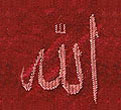|
|
||||||||||||||||||||||
| Masterpieces of Persian Art Safavid Textiles Arthur Upham Pope The Mongol domination - from about the middle of the thirteenth, through the fourteenth century - while at first having little influence on pottery, metal, or architecture, sharply changed the character of Persian textile design. The pre-Islamic themes are abandoned. The old composition schemes, figures, and style are all dropped. The standard color choice of a light - often white - ground with a very dark tone to give a maximum contrast which would enchance both silhouette and graphic effects, now goes out of use. Heavy dark tones are preferred, giving an effect of complete opacity, and the only decisive contrast commonly sought is achieved with metal thread (gilded membrane wound on a core), solidly plated in large spots on depp-toned lustrous grounds. Even the choice of techniques alters. Instead of light, mat cloths predominating, with occasional serges and a few satins, satins or the close alternative, warp twills, are customary. The effort is for striking ostentation, rich but obvious effects which require no exploration. Palmettes, often of lotus origin, are typical; fabulous birds and beasts of Chinese origin, or picturesque birds semi-decoratively treated are assembled in simple repeats, often devised to produce a diagonal movement. The style with scarcely distinguishable variations was practiced over the full extent of the Mongol political and cultural empire, and the source of most of the characteristic examples may remain undetermined - without, indeed, much real loss to historical knowledge. During the rule of the Timurids in the fifteenth century, patterns seem to have become more delicate and graceful in drawing, more open in composition, but the only evidence is indirect, for not a shred of Persian woven material is known datable between about 1400 and the full flowering of the Safavid culture in the second half of the sixteenth century. Only illustrations of textiles in miniatures give some clue to the development, and these are subject to deflection by the personality of the recording artist: first by the accident of his choice; and second by the intrusion of his own style in the rendition, or even by arbitrary invention on his part. 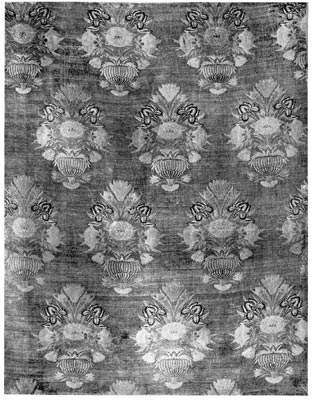 When real silks become again available a new fashion is fimly established,
with the evolution of arabesque traceries, on the one hand, and on
the other, and far more important for textiles, the maturing of an
accomplished floral naturalism.
When real silks become again available a new fashion is fimly established,
with the evolution of arabesque traceries, on the one hand, and on
the other, and far more important for textiles, the maturing of an
accomplished floral naturalism.Specimens are abundant only from the reign of Shah Abbas I on, and then the abundance is almost embarrassing, For court costumes one of the preferred and most characteristic classes consists of metal-ground fabrics (compound cloths or weft twills with fairly numerous technical variations) in which the surface is a solid sheet of the metal thread (Pl. 154) usually silver, or perhaps striped alternately in the two metals, and the sprays or bouquets of flowers are in soft glossy silk reproducing as closely as possible the actual hues. A nightingale, proportionately huge, a deer, proportionately minute, or a normal butterfly are usual accessories, and the rendition of some details in gold against the silver makes even more sumptuous the deliberate lavishness. Equally characteristic are crisp but substantial taffetas with definite weft ribs, brocaded with similar flower clusters more widely spaced than the pattern-unit scale, with the edges all outlined in metal thread. Favorite colors for these are an intense salmon-rose and turquoise blue. But in these and other materials of the time neutrals are most effectively used - shades of beige, tan, tobacco, grays, puce, and true violets which nevertheless function neutrally. 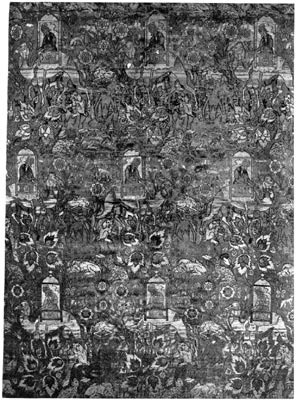 Two
technical innovations stimulate distinctive adaptations of the repertoire:
multiple cloths and velvet. Multiple cloths, in which two or three
plain cloths are woven as if each were independent, yet are passed
back and forth to define the pattern and vary the color range, were
utilized with every refinement of the technique for the execution
of most difficult cartoons, and the great master in this medium was
one of the supreme exponents of the textile arts of all times: Ghiyath
ad-Din Ali of Yazd (Pl. 148, 149). With the constantly modified interpenetration
of three otherwise integral cloths, green, rose and white, he effects
a complex mosaic of asymmetrical panels framing not only delicate
floweres and actively naturalistic birds and animals, but actually
a portrait of a typical young courtier, relaxed very much at his ease.
No wonder Ghiyath was a rich man, a favored intimate of royalty, his
achievements in demand even in the far off capitals of Moghul India,
Ottoman Turkey, and the West. Two
technical innovations stimulate distinctive adaptations of the repertoire:
multiple cloths and velvet. Multiple cloths, in which two or three
plain cloths are woven as if each were independent, yet are passed
back and forth to define the pattern and vary the color range, were
utilized with every refinement of the technique for the execution
of most difficult cartoons, and the great master in this medium was
one of the supreme exponents of the textile arts of all times: Ghiyath
ad-Din Ali of Yazd (Pl. 148, 149). With the constantly modified interpenetration
of three otherwise integral cloths, green, rose and white, he effects
a complex mosaic of asymmetrical panels framing not only delicate
floweres and actively naturalistic birds and animals, but actually
a portrait of a typical young courtier, relaxed very much at his ease.
No wonder Ghiyath was a rich man, a favored intimate of royalty, his
achievements in demand even in the far off capitals of Moghul India,
Ottoman Turkey, and the West.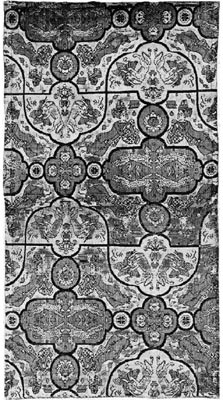 The
romance of Laila and Majnun, one of the perennial tragic love-stories
of Persia, seems to have especially absorbed this master - who was
a poet in his own right as well as draftsman, weaver, entrepreneur,
financier, wit, and at the end of his life, religious. On a satin
(Pl. 148), Laila riding on her camel to the desert-wastes, where her
repining lover has become a hermit, is enmeshed in semi-conventional
plant ornament. The continuity of the foliation prevents the mechanical
recurrence of the figural motive from being too conspicuous and hence
conflicting too sharply with its illustrative function; yet the intrinsic
interest of this otherwise minor element makes it the real theme of
the composition. The
romance of Laila and Majnun, one of the perennial tragic love-stories
of Persia, seems to have especially absorbed this master - who was
a poet in his own right as well as draftsman, weaver, entrepreneur,
financier, wit, and at the end of his life, religious. On a satin
(Pl. 148), Laila riding on her camel to the desert-wastes, where her
repining lover has become a hermit, is enmeshed in semi-conventional
plant ornament. The continuity of the foliation prevents the mechanical
recurrence of the figural motive from being too conspicuous and hence
conflicting too sharply with its illustrative function; yet the intrinsic
interest of this otherwise minor element makes it the real theme of
the composition.The most remarkable figural velvets of the period are quite likely, judging from the style, also creations of this distinctive personality, though only one bears his signature. These three designs, together with three or four other purely floral patterns, all come from a tent formerly in the possession of the Sanguszko family in Poland, which was captured, according to the family records, at the siege of Vienna in 1683; but at that time the cartoons, and undoubtedly the velvets themselves, were seventy-five or eighty years old. The signed piece illustrates another oft-told Persian love tale, of Khusrau the Sasanian king, and his infatuation for the beautiful Shirin. But far more effective and technically remarkable is a hunting compostion, of which by far the largest piece, the roundel from the top of the tent, is in the Boston Museum (Pl. C). Hunters ahorse and afoot, with bows, swords, daggers, or spying from behind boulders, brave infuriated lions and leopards, watch for a chance at wild goats, or miss a herd of deer in swift flight. It is the old Sasanian theme, but now purely a sporting event. The figures are drawn with the vigorous movement and easy naturalism of the miniature painter, despite the impediments of the difficult pile technique. The animals are violent, wary, light-footed, even inquisitive, according to species and circumstance. And the heaps of polychrome rocks, the occasional slanting tree, the spattering of flowers, create the illusion of an actual landscape. The colors are like liquid enamels. 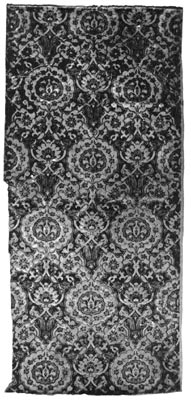 The
arabesque style and the related formal repertoire were more fully
worked out in knotted pile carpets but also did find satisfactory
application in this medium as well. One of the finest remaining examples
(Pl. 147) has the composition built on the double interlacing ogival
lattice so characteristic of the “Vase” carpets (Pl. H);
but the shallow-scalloped medallions, on the other hand, the fine-petalled
lotus palmettes, the delicately serrated vine leaves, the chains of
dainty flowerets, and the long-tailed birds are all features of the
Kashan silk carpets, and Kashan was famous for fine fabrics, especially
for velvets - justly, as this piece convincingly demonstrates. The
arabesque style and the related formal repertoire were more fully
worked out in knotted pile carpets but also did find satisfactory
application in this medium as well. One of the finest remaining examples
(Pl. 147) has the composition built on the double interlacing ogival
lattice so characteristic of the “Vase” carpets (Pl. H);
but the shallow-scalloped medallions, on the other hand, the fine-petalled
lotus palmettes, the delicately serrated vine leaves, the chains of
dainty flowerets, and the long-tailed birds are all features of the
Kashan silk carpets, and Kashan was famous for fine fabrics, especially
for velvets - justly, as this piece convincingly demonstrates.Ghiyath’s figural style had been shaped by sixteenth century influences, the first Safavid phase. The second phase, developed within the lifetime and court of Shah Abbas I (r. 1589-1627), was dominated and almost wholly determined by the marked character of his chief painter, Riza Abbasi and his striking types were imitated on numerous velvets, quite different in spirit from those of Ghiyath. Instead of a composition of small figures bound together by a common setting and activity to which each individual was subordinated, Riza portrayed the individual and reduced the setting to incidental space filling. 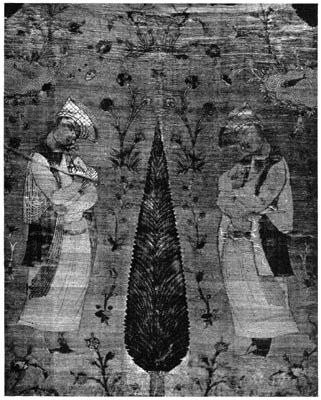 Characteristic
of the applied designs produced in this manner by his followeres -
numerous, in general mediocre, but oftern carelessly equated with
their leader - is a velvet, one of a set of three brought on the market
from the royal treasure of Jaipur (Pl. 150). A simpering court favorite,
the plump sloe-eyed youth admired at the time, clad in the careless
elegance which betrays the softening of manners and other standards
incidental to success and mounting prosperity, stands relaxed and
indolent, enchanted by the scent of a flower. Repeated in overturn,
the confronted figures flank a conventional cypress with a pool at
its foot, a frivolous travesty of a once-sacred cosmological grouping.
The texture is exquisite, the color lovely, the rendition completely
in control. That the result is hardly great is a criticism of the
life of the time. Characteristic
of the applied designs produced in this manner by his followeres -
numerous, in general mediocre, but oftern carelessly equated with
their leader - is a velvet, one of a set of three brought on the market
from the royal treasure of Jaipur (Pl. 150). A simpering court favorite,
the plump sloe-eyed youth admired at the time, clad in the careless
elegance which betrays the softening of manners and other standards
incidental to success and mounting prosperity, stands relaxed and
indolent, enchanted by the scent of a flower. Repeated in overturn,
the confronted figures flank a conventional cypress with a pool at
its foot, a frivolous travesty of a once-sacred cosmological grouping.
The texture is exquisite, the color lovely, the rendition completely
in control. That the result is hardly great is a criticism of the
life of the time.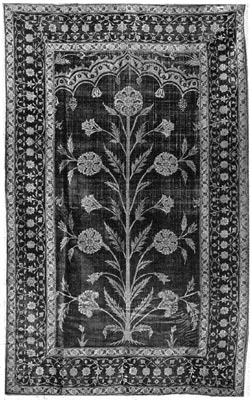 The
Yazd weavers, of whom Ghiyath was the standard-bearer, specialized
in panels decorated with a single large-scale blossoming plant, most
typically a lily but sometimes a poppy, in an architectural frame
suggested by the mihrab arch. Closely similar velvets were also woven
in India where, as other evidence likewise shows, Yazd weavers had
evidently been imported when the court looms were being manned; and
there are “borderline” cases which could have been produced
either before or after the exodus. The attribution of any one example
of this literally Indo-Persian art is of little or no consequence,
but the tonality of red in one of the poppy panels (Pl. 151) and the
excessive fineness of the border design in relation to the gigantic
main motive suggest that the creator had already been established
for some time in India. The fact that these velvets are handsome and
instantly striking, though meticulous, rather than subtle, or sensitive,
also points to Mughal taste. The
Yazd weavers, of whom Ghiyath was the standard-bearer, specialized
in panels decorated with a single large-scale blossoming plant, most
typically a lily but sometimes a poppy, in an architectural frame
suggested by the mihrab arch. Closely similar velvets were also woven
in India where, as other evidence likewise shows, Yazd weavers had
evidently been imported when the court looms were being manned; and
there are “borderline” cases which could have been produced
either before or after the exodus. The attribution of any one example
of this literally Indo-Persian art is of little or no consequence,
but the tonality of red in one of the poppy panels (Pl. 151) and the
excessive fineness of the border design in relation to the gigantic
main motive suggest that the creator had already been established
for some time in India. The fact that these velvets are handsome and
instantly striking, though meticulous, rather than subtle, or sensitive,
also points to Mughal taste.Even more ambiguous in an exceptional printed and painted cotton panel (Pl. 152), with a combination of fantastic trees, delicate animals, fine-scale semi-conventional flowers, and purely conventional motives in strange combinations of dark green, bright red, and two tones of violet. The character of the trees, the animal drawing, and the tonality all seem Indian; yet no close Indian counterpart is known though painted Indian cottons are numerous. 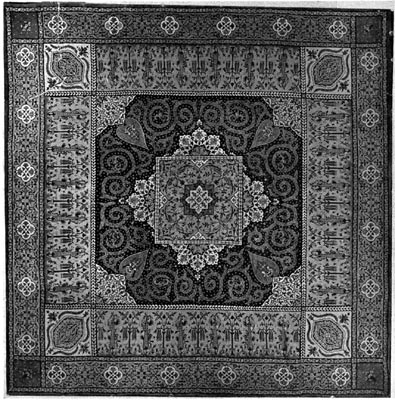 But
the decorative effectiveness of the piece and the skill which went
into both its design and execution cannot be gainsaid. But
the decorative effectiveness of the piece and the skill which went
into both its design and execution cannot be gainsaid.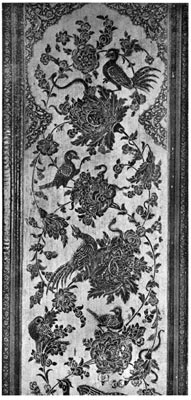 The painted ornament on an unusual shirt (PL. 153) belongs really
within the domain of the art of the book rather than to the textile
crafts. For these roundels, panels, and multiple bands are filled
with manuscript illuminations, Koranic texts and prayers which are
only by reason of its special purpose rendered in a garment instead
of on pages. Yet the adaptation to this use is successful beyond theoretical
propriety. A soberly rich costume results, ecclesiastical in every
quality. A suppliant so clothed in righteousness whose prayers are
by his garment so reinforced by classical and tested appeals could
perform his orison with greater confindence. Whether this support
to piety was for a king or some great figure in Islam we can only
guess.
The painted ornament on an unusual shirt (PL. 153) belongs really
within the domain of the art of the book rather than to the textile
crafts. For these roundels, panels, and multiple bands are filled
with manuscript illuminations, Koranic texts and prayers which are
only by reason of its special purpose rendered in a garment instead
of on pages. Yet the adaptation to this use is successful beyond theoretical
propriety. A soberly rich costume results, ecclesiastical in every
quality. A suppliant so clothed in righteousness whose prayers are
by his garment so reinforced by classical and tested appeals could
perform his orison with greater confindence. Whether this support
to piety was for a king or some great figure in Islam we can only
guess.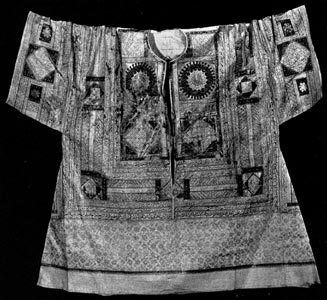 The
skill, range of ideas, and material resources built up in the shops
of this great commercial monarch sustained the craft at a highly respectable
level through nearly a century of gradual political, social, and economic
decline. Then the shock of the Afghan invasion (1722) was devastating
to this as to practically every other phase of Persian culture. By
the time that there was an opportunity for recuperation, the western
textile industry was mechanized for quantity production. The
skill, range of ideas, and material resources built up in the shops
of this great commercial monarch sustained the craft at a highly respectable
level through nearly a century of gradual political, social, and economic
decline. Then the shock of the Afghan invasion (1722) was devastating
to this as to practically every other phase of Persian culture. By
the time that there was an opportunity for recuperation, the western
textile industry was mechanized for quantity production.Persia’s next adjustment will be to these conditions. But whether, in the necessary technical revolution any intrinsic values can be recovered, at least in this craft, remains to be seen. Design can still be good for machine weaving; chemists can make dyes that are true, beautiful, and enduring, though they rarely do; the range of possible textures and of texture compositions is increased. The way is there. But can the will be evoked? |
|
|||||||||||||||||||||||||||||||||||||||||||||||||||||
